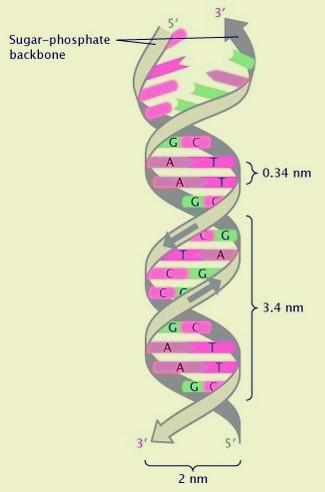
DNA strands are antiparallel because of
A. H-bonds
B. Phosphodiester bonds
C. Disulfide bonds
D. Peptide bonds
Answer
513.3k+ views
Hint: The bonds resulting in the antiparallel polarity of DNA double-strand are usually formed between a highly electronegative atom and an element of group 1. It can either form triple or double bonds between nitrogenous bases.
Complete answer:
The DNA polymerases that replicate DNA and transcribe RNA from DNA can read the template strand only in the 3' to 5' direction to synthesize in the 5' to 3' directions. The main reason for this antiparallel nature of the DNA is stability. The phosphodiester bond links the phosphate group to the hydroxyl group of the sugar molecule, due to which the DNA polymer has two free ends, the 3’ end and the 5’end. Now only if these two strands are present in an anti-parallel fashion, the stability obtained will be maximum. The strands can also be parallel but, in that case, no triple hydrogen bond between guanine and cytosine nitrogenous bases will occur and this will make it less stable. DNA replication will also be impossible if the strands are not arranged in anti-parallel fashion. Further stacking of base pairs occurs in anti-parallel conditions and this results in base stacking interactions which provide further stability.
Additional Information:
Some structural features of DNA are:

- Nucleotides are composed of sugar, phosphate, and a nitrogenous base. Many nucleotides join together by a phosphodiester bond to form a polynucleotide structure.
- Three types of bonds are present in DNA. N-glycosidic bonds are present between the nitrogenous base and pentose sugar. The phosphodiester bond is formed between 5’ carbon of one sugar of one nucleotide and 3’ carbon of another sugar of the next nucleotide. Hydrogen bonds are present between nitrogenous bases in a base pair. Three hydrogen bonds are present between guanine and cytosine. Two hydrogen bonds are present between adenine and thymine.
- The polynucleotide chain has sugar and phosphate backbone and bases are present at right angles to it.
So, the correct answer is, “DNA strands are antiparallel because of H-bonds.”
Note: The main reason why DNA strands are antiparallel is due to the high level of stability achieved in an antiparallel configuration. DNA can also exist in parallel configuration but the base pairing will be different (reverse Watson and Crick base pairing) and stability will be less. But in this question, the most appropriate answer would be hydrogen bonds.
Complete answer:
The DNA polymerases that replicate DNA and transcribe RNA from DNA can read the template strand only in the 3' to 5' direction to synthesize in the 5' to 3' directions. The main reason for this antiparallel nature of the DNA is stability. The phosphodiester bond links the phosphate group to the hydroxyl group of the sugar molecule, due to which the DNA polymer has two free ends, the 3’ end and the 5’end. Now only if these two strands are present in an anti-parallel fashion, the stability obtained will be maximum. The strands can also be parallel but, in that case, no triple hydrogen bond between guanine and cytosine nitrogenous bases will occur and this will make it less stable. DNA replication will also be impossible if the strands are not arranged in anti-parallel fashion. Further stacking of base pairs occurs in anti-parallel conditions and this results in base stacking interactions which provide further stability.
Additional Information:
Some structural features of DNA are:

- Nucleotides are composed of sugar, phosphate, and a nitrogenous base. Many nucleotides join together by a phosphodiester bond to form a polynucleotide structure.
- Three types of bonds are present in DNA. N-glycosidic bonds are present between the nitrogenous base and pentose sugar. The phosphodiester bond is formed between 5’ carbon of one sugar of one nucleotide and 3’ carbon of another sugar of the next nucleotide. Hydrogen bonds are present between nitrogenous bases in a base pair. Three hydrogen bonds are present between guanine and cytosine. Two hydrogen bonds are present between adenine and thymine.
- The polynucleotide chain has sugar and phosphate backbone and bases are present at right angles to it.
So, the correct answer is, “DNA strands are antiparallel because of H-bonds.”
Note: The main reason why DNA strands are antiparallel is due to the high level of stability achieved in an antiparallel configuration. DNA can also exist in parallel configuration but the base pairing will be different (reverse Watson and Crick base pairing) and stability will be less. But in this question, the most appropriate answer would be hydrogen bonds.
Recently Updated Pages
Express the following as a fraction and simplify a class 7 maths CBSE

The length and width of a rectangle are in ratio of class 7 maths CBSE

The ratio of the income to the expenditure of a family class 7 maths CBSE

How do you write 025 million in scientific notatio class 7 maths CBSE

How do you convert 295 meters per second to kilometers class 7 maths CBSE

Write the following in Roman numerals 25819 class 7 maths CBSE

Trending doubts
Give 10 examples of unisexual and bisexual flowers

Draw a labelled sketch of the human eye class 12 physics CBSE

Franz thinks Will they make them sing in German even class 12 english CBSE

Draw a diagram of a flower and name the parts class 12 biology ICSE

What is the Full Form of PVC, PET, HDPE, LDPE, PP and PS ?

The speed of light will be minimum while passing through class 12 physics CBSE




